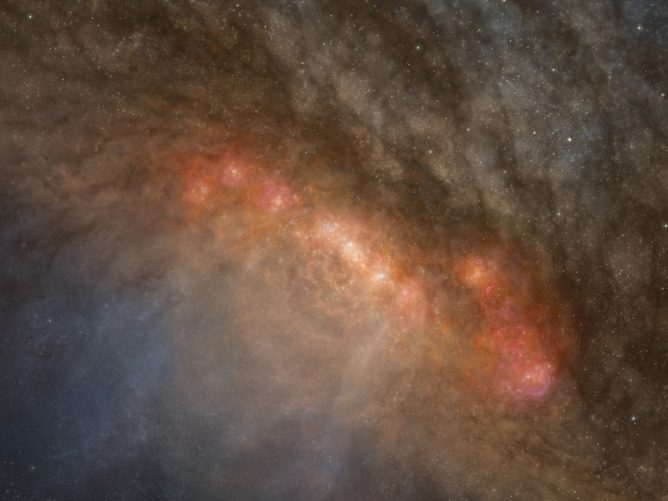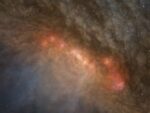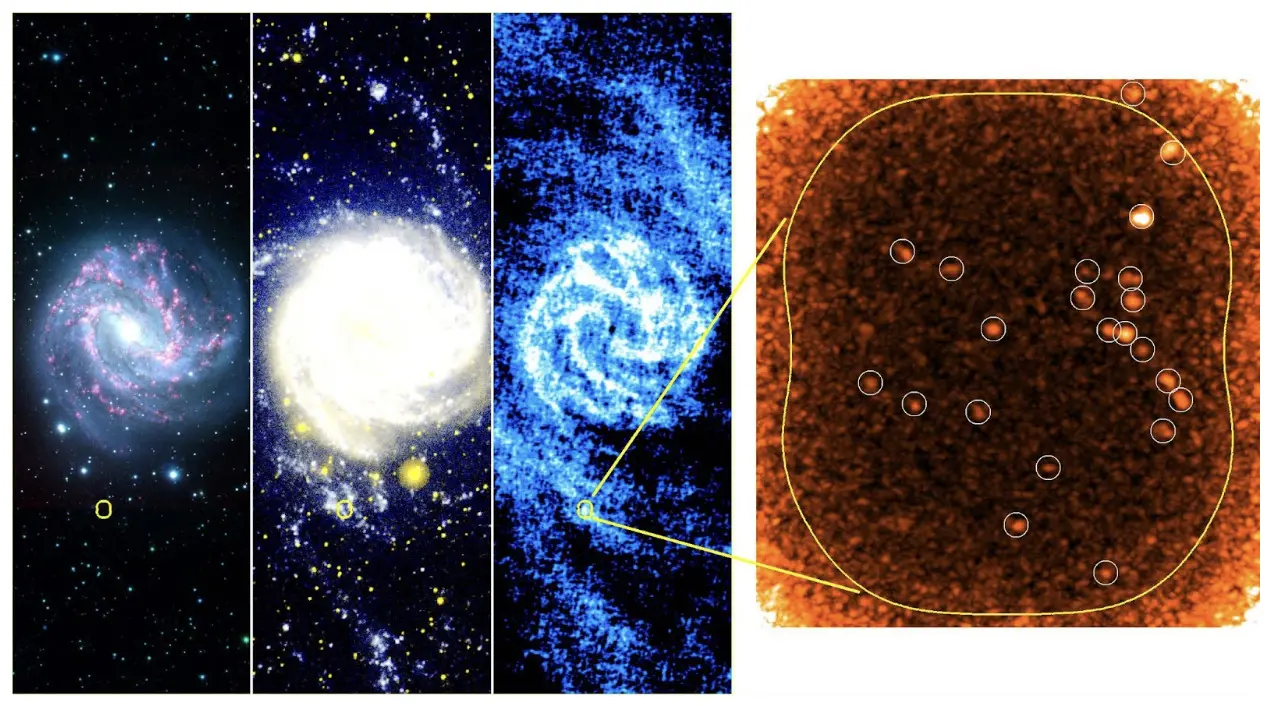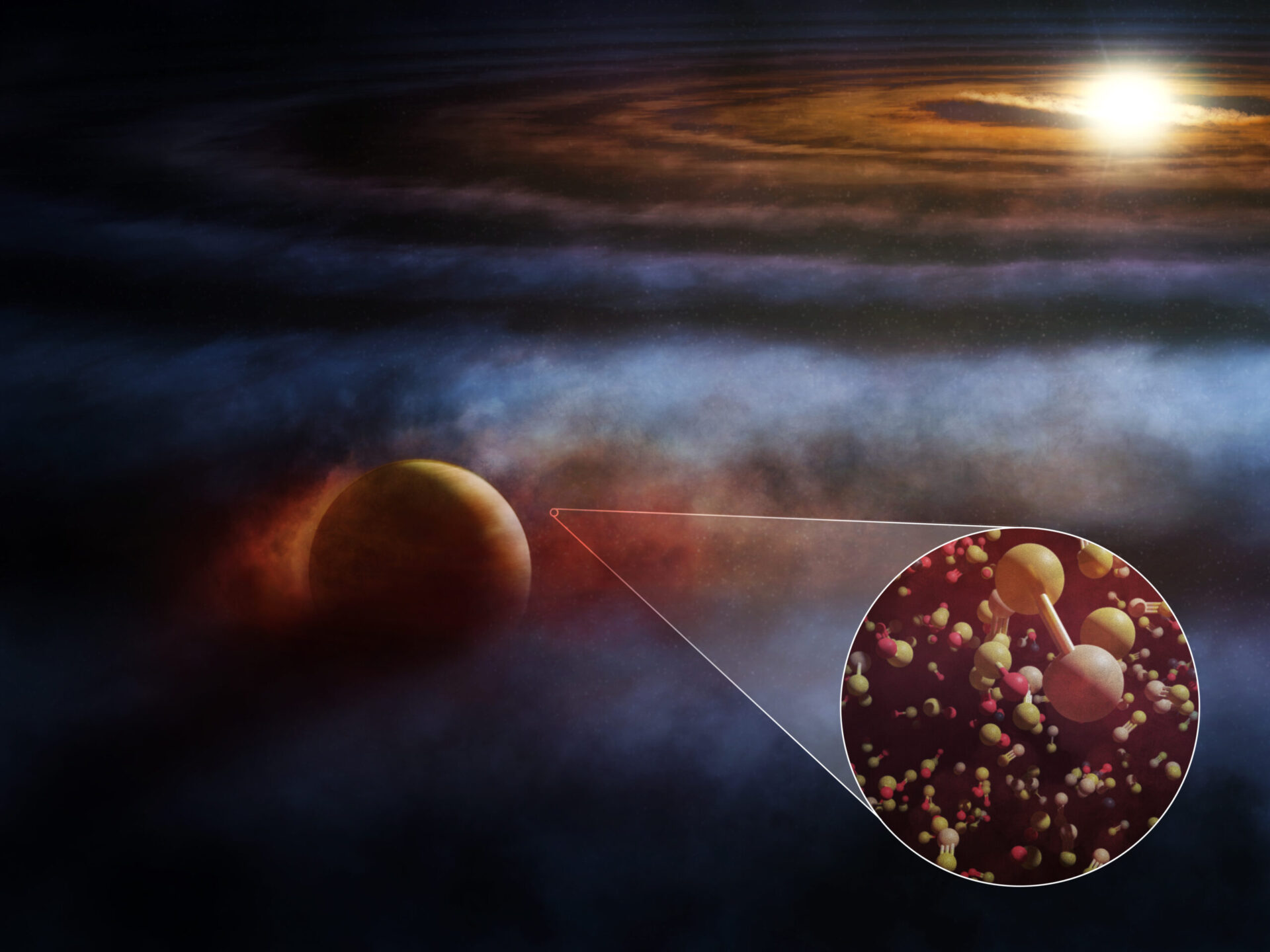ALMA Unlocks the Chemical Secrets of a Starburst Galaxy
Astronomers observed with the Atacama Large Millimeter/submillimeter Array (ALMA) the center of a relatively nearby galaxy known as NGC 253, which produces stars at a very high rate. With more than 300 hours of observation, they detected more than one hundred molecular species, far more than previous studies outside the Milky Way have detected. The high sensitivity of ALMA successfully detected molecules representing various stages of star evolution in the central region of NGC 253, and the high angular resolution of ALMA resolved the locations where these stages are taking place. This wealth of data has allowed astronomers to understand better the physics and chemistry of this kind of galaxy. The wideband sensitivity upgrade as a part of the ALMA 2030 Development roadmap will make wide-frequency observations like this study much more efficient. We expect that the understanding of the starburst mechanism will advance through the simultaneous observation of more tracer molecules.
In the Universe, some galaxies form stars much faster than the Milky Way (our galaxy). These galaxies are called starburst galaxies. Starburst phenomena do not last forever. It is still a mystery how exactly such a highly prolific formation of stars can occur and how it ends. The chance for stars to form depends on the properties of the raw material from which stars are born, such as molecular gas, a gaseous material of various molecules. For example, stars form in dense regions within molecular clouds where gravity can act more effectively. Sometime after the active formation of stars, existing stars and explosions of dead stars impart energy to the surrounding medium, which could hinder future star formation. These physical processes impact the chemistry of the galaxy and imprint a signature in the strengths of signals from molecules. Because each molecule emits at specific frequencies (see Figure 2 top), observations over a wide frequency range enable us to analyze the physical properties and give us insights into the mechanism of starbursts.
Astronomers have gained a new understanding of phenomena related to star birth in a starburst galaxy. They detected more than one hundred molecular species in the center of a starburst galaxy, NGC 253, located about 10 million light-years away. This chemical feedstock is the richest found outside the Milky Way, and it includes molecules that have been detected for the first time beyond the Milky Way, such as ethanol and the phosphorus-bearing species PN. The observations were performed using the Atacama Large Millimeter/submillimeter Array (ALMA), a radio telescope in Chile. This survey was conducted as an ALMA Large Program named the ALMA Comprehensive High-resolution Extragalactic Molecular Inventory (ALCHEMI), led by Sergio Martín of the European Southern Observatory/Joint ALMA Observatory, Nanase Harada of the National Astronomical Observatory of Japan, and Jeff Mangum of the National Radio Astronomy Observatory.
First, this survey found that high-density molecular gas will likely promote active star formation in this galaxy. Each molecule emits at multiple frequencies, and their relative and absolute signal strengths change according to the density and the temperature. By analyzing numerous signals of some molecular species, the amount of dense gas in the center of NGC 253 turned out to be more than ten times higher than that in the center of the Milky Way, which could explain why NGC 253 is forming stars about 30 times more efficiently even with the same amount of molecular gas.
One mechanism that could aid the compression of molecular clouds into denser ones is a collision between such clouds. At the center of NGC 253, cloud collisions likely occur where streams of gas and stars intersect, generating shock waves traveling at supersonic speeds. These shock waves evaporate molecules such as methanol and HNCO, freezing onto icy dust particles. When the molecules evaporate as gas, they become observable by radio telescopes such as ALMA.
Certain molecules also trace ongoing star formation. It has been known that complex organic molecules are abundant around young stars. In NGC 253, this study suggests that active star formation creates a hot and dense environment similar to the ones seen around individual young stars (protostars) in the Milky Way. The amount of complex organic molecules in the center of NGC 253 is similar to that around protostars in the galaxy.
In addition to physical conditions that could promote star formation, the survey also revealed the harsh environment left by previous generations of stars, which could slow down future star formation. When massive stars die, they cause massive explosions known as supernovae, which emit energetic particles called cosmic rays. The molecular composition of NGC 253 revealed from the enhancement of species such as H3O+ and HOC+ that molecules in this region have had some of their electrons stripped off by cosmic rays at a rate at least 1000 times higher than that near the Solar System. This suggests a considerable energy input from supernovae, which makes it difficult for gas to condense to form stars.
Finally, the ALCHEMI survey provided an atlas of 44 molecular species, doubling the number available from previous studies outside the Milky Way. By applying a machine-learning technique to this atlas, the researchers could identify which molecules can most effectively trace the story of star formation mentioned above – from the beginning to the end. As described above with some examples, certain molecular species trace phenomena such as shock waves or dense gas, which could aid star formation. Young star-forming regions host rich chemistry, including complex organic molecules. Meanwhile, the developed starburst shows an enhancement of the cyano radical that indicates energy output from massive stars in the form of UV photons, which could also hinder future star formation. Finding these tracers may help to plan future observations using the wideband sensitivity upgrade expected this decade as a part of the ALMA 2030 Development roadmap, with which simultaneous observations of multiple molecular transitions will become much more manageable.
“ALMA is the only instrument capable of providing the sensitivity and resolution for this kind of study. Thanks to the possibility of observing large programs (requiring more than 50 hours of observations), we managed to compile a comprehensive study of the chemistry of this extragalactic object that can be directly compared to the one found in the Milky Way and the Solar System” explains Sergio Martín, Principal Investigator of this study, and Head of the Department of Science Operations at ALMA. “With the new updates being performed during this decade to the observatory, known as the Wideband Sensitivity Upgrade (WSU), we will be able to extend this kind of study to fainter and further objects to understand the evolution of chemistry in the Universe”.
Additional Information
This study is composed of multiple publications:
- Harada et al. (ApJS 2024) “The ALCHEMI atlas: principal component analysis reveals starburst evolution in NGC 253” 10.3847/1538-4365/ad1937 published on Mar 15th, 2024
- Martin et al. (A&A 2021) “ALCHEMI, an ALMA Comprehensive High-resolution Extragalactic Molecular Inventory. Survey presentation and first results from the ACA array” 10.1051/0004-6361/202141567
- Tanaka et al. (ApJ 2024) “Volume Density Structure of the Central Molecular Zone NGC 253 through ALCHEMI Excitation Analysis” 10.3847/1538-4357/ad0e64
- Huang et al. (A&A 2023) “Reconstructing the shock history in the CMZ of NGC 253 with ALCHEMI” 10.1051/0004-6361/202245659
- Behrens et al. (ApJ 2022) “Tracing Interstellar Heating: An ALCHEMI Measurement of the HCN Isomers in NGC 253” 10.3847/1538-4357/ac91ce
- Harada et al. (ApJ 2022) “ALCHEMI Finds a “Shocking” Carbon Footprint in the Starburst Galaxy NGC 253″ 10.3847/1538-4357/ac8dfc
- Humire et al. (A&A 2022) “Methanol masers in NGC 253 with ALCHEMI” 10.1051/0004-6361/202243384
- Holdship et al. (A&A 2022) “Energizing Star Formation: The Cosmic-Ray Ionization Rate in NGC 253 Derived from ALCHEMI Measurements of H3O+ and SO” 10.3847/1538-4357/ac6753
- Haasler et al. (A&A 2022) “First extragalactic detection of a phosphorus-bearing molecule with ALCHEMI: Phosphorus nitride (PN)” 10.1051/0004-6361/202142032
- Harada et al. (2021 ApJ) “Starburst Energy Feedback Seen through HCO+/HOC+ Emission in NGC 253 from ALCHEMI” 10.3847/1538-4357/ac26b8
- Barrientos et al. (Experimental Astronomy 2021) “Towards the prediction of molecular parameters from astronomical emission lines using Neural Networks” 10.1007/s10686-021-09786-w
- Holdship et al. (A&A 2021) “The distribution and origin of C2H in NGC 253 from ALCHEMI” 10.1051/0004-6361/202141233
- Butterworth et al. (A&A in press) “Molecular isotopologue measurements toward super star clusters and the relation to their ages in NGC253 with ALCHEMI” 10.48550/arXiv.2402.10721
The Atacama Large Millimeter/submillimeter Array (ALMA), an international astronomy facility, is a partnership of ESO, the U.S. National Science Foundation (NSF) and the National Institutes of Natural Sciences (NINS) of Japan in cooperation with the Republic of Chile. ALMA is funded by ESO on behalf of its Member States, by NSF in cooperation with the National Research Council of Canada (NRC) and the National Science and Technology Council (NSTC) in Taiwan and by NINS in cooperation with the Academia Sinica (AS) in Taiwan and the Korea Astronomy and Space Science Institute (KASI).
ALMA construction and operations are led by ESO on behalf of its Member States; by the National Radio Astronomy Observatory (NRAO), managed by Associated Universities, Inc. (AUI), on behalf of North America; and by the National Astronomical Observatory of Japan (NAOJ) on behalf of East Asia. The Joint ALMA Observatory (JAO) provides the unified leadership and management of the construction, commissioning and operation of ALMA.
Images
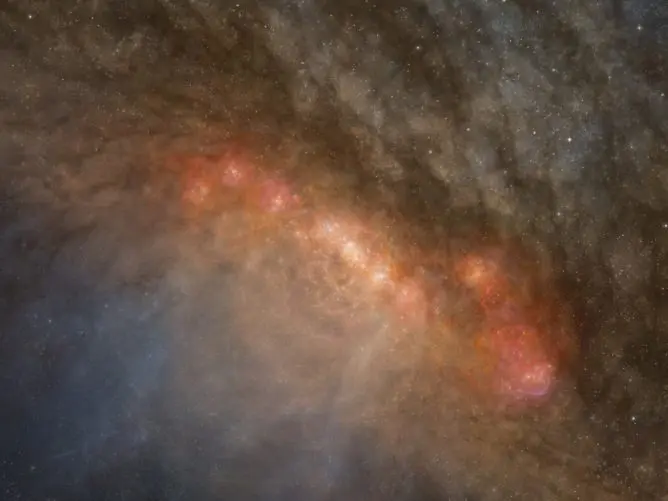
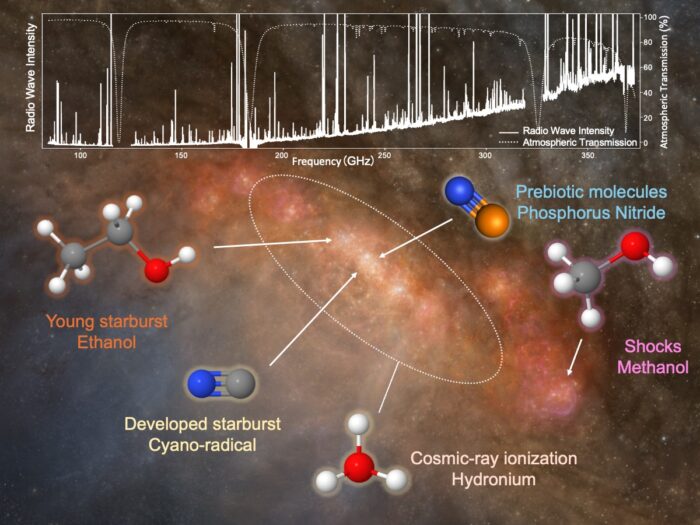
Contacts
-
Nicolás Lira
Education and Public Outreach CoordinatorJoint ALMA Observatory, Santiago - ChilePhone: +56 2 2467 6519Cel: +56 9 9445 7726Email: [email protected] -
Naoko Inoue
EPO officer, ALMA ProjectNational Astronomical Observatory of Japan (NAOJ)Email: [email protected] -
Jill Malusky
Public Information Officer -
Bárbara Ferreira
ESO Media Manager
